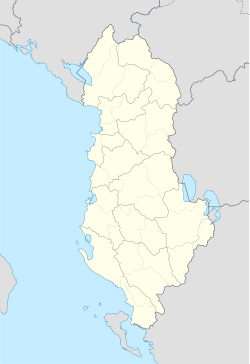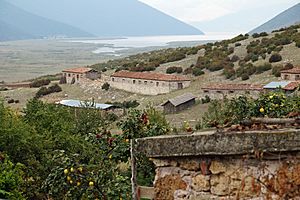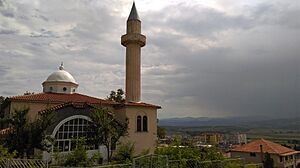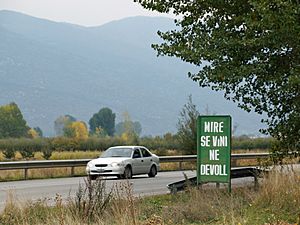Devoll (municipality) facts for kids
Quick facts for kids
Devoll
|
||
|---|---|---|
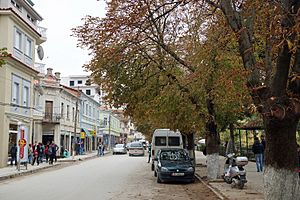
Bilisht
|
||
|
||
| Country | ||
| County | Korçë | |
| Seat | Bilisht | |
| Area | ||
| • Municipality | 453.27 km2 (175.01 sq mi) | |
| Population
(2011)
|
||
| • Municipality | 26,716 | |
| • Municipality density | 58.9406/km2 (152.655/sq mi) | |
| Time zone | UTC+1 (CET) | |
| • Summer (DST) | UTC+2 (CEST) | |
| Postal Code |
7006
|
|
| Area Code | (0)811 | |
Devoll (pronounced roughly like deh-VOL) is a municipality in southeastern Albania. It's located in Korçë County. The main town and center of Devoll is Bilisht.
Devoll gets its name from the Devoll River, which flows through its valley. This area is an important border point. The Kapshticë crossing connects Devoll with Greece. Devoll shares borders with other Albanian municipalities like Kolonjë, Korçë, Maliq, and Pustec. The municipality covers an area of about 453 square kilometers. In 2011, about 26,716 people lived here.
Contents
History
Ancient Times and Medieval Fortresses
Long ago, people lived in Devoll. Scientists found ancient pottery from the Late Bronze Age in a cave called Tren. This pottery might have been made right there!
During the Middle Ages, there was a very important fortress called Devol. In 1108, a famous agreement, the Treaty of Devol, was signed there. This treaty was between Bohemond I of Antioch and the Byzantine Emperor Alexios I Komnenos. The exact spot of this fortress was forgotten for a long time. Today, experts think it might be near a place called Zvezdë.
The Bulgarian Empire took control of the Devol fortress in the early 1200s. But the Byzantines took it back in 1259. This fortress was very important until the 1300s.
People and Changes Over Time
Around 1328, an emperor named John VI Kantakouzenos wrote about meeting local Albanians in the Devoll region. This shows that Albanian people have lived here for a very long time.
During the First World War, some villages in Devoll were burned. One sad event was the killing of Baba Hafiz, a religious leader, by Greek troops in 1914. His bloodstained cap became a symbol in his religious center for many years.
There's a special chapel in the Blashtonjë cave near the Small Prespa Lake. It dates back to the 1200s. The cave paintings there are the oldest artworks found in Albania. The icons in the chapel are also among the oldest in the country.
In 1355, Emperor Stefan Dušan died in Devoll. At that time, the region was part of the Serbian Empire.
In the past, many Christians from Devoll moved to other countries and then came back. Later, some Muslims did the same. Before Second World War, Devoll was a special area. After the Communist period, it became a new municipality in 2015.
Today, many people are still moving away from Devoll, especially young Muslims. This is a change from the past, when more Christians left.
Geography
Location and Borders
Devoll is located in the southeastern part of Albania. The Kapshticë border crossing is very close to Albania's easternmost point. The entire eastern and southern edges of Devoll are the national border with Greece. To the west and north, Devoll borders other Albanian municipalities like Kolonjë, Korçë, Maliq, and Pustec.
Rivers, Mountains, and Lakes
The municipality is in the upper part of the Devoll River. This river starts in the southwestern area of Devoll. The town of Bilisht is about 900 meters above sea level. It sits on a flat area surrounded by mountains. The Kapshticë border town is even higher, at 1048 meters.
The western border of Devoll is formed by the Malet e Moravës mountain range. Its highest peak is Maja e Lartë, which is 1806 meters tall. The city of Korçë is on the other side of these mountains. There are only three ways to cross these mountains.
In the northwest, the Devoll River flows through a narrow canyon into the Korçë Plain. In the northeast, a long part of the Small Prespa Lake reaches almost to the Bilisht Plain. In the southeast, the plain drops off into the Kore river valley. This river is a small part of Albania that drains into the Aegean Sea, not the Adriatic or Ionian Seas.
Farming and Resources
The Bilisht Plain is very fertile because of many irrigation canals. When there's a lot of rain or snow melts, water flows from the Small Prespa Lake into the Devoll River and then into the Adriatic Sea. For many years, the Devoll River was redirected into the Small Prespa Lake during floods. This extra water was used to water the Korçë Plain.
In the mountains east of Bilisht, near the Greek border, there are rich deposits of nickel. These are found mainly in two areas: Verniku and Kapshtica West.
Demography
People and Languages
Most people in Devoll are ethnically Albanian. In the past, most Albanians here were Muslim, but a smaller group, especially in the mountains, were Orthodox Christian. The Albanian Christians live mostly in the upper Devoll river valley, in Hoçisht, Bilisht, and Tren. They prefer to be called only Albanian.
There are also communities of Greeks and Aromanians in the area. Some Albanians who moved to Greece have also become Orthodox Christian.
You can also find Roma and Macedonians in the village of Vërnik. The Slavic-speaking people in Vernik identify as Aegean Macedonians. The Roma are mostly Muslim, and the Macedonians are Orthodox Christians.
Culture and Identity
Today, many young Albanians in Devoll have parents from both Muslim and Christian backgrounds. They often feel connected to both traditions, sometimes calling themselves "half-Muslim, half-Christian." Like in other parts of Albania, people might not practice their religion strictly. However, religious identity can still be important in how people relate to each other, especially for older generations.
The Albanian people in Devoll speak a Tosk dialect. The Macedonian people speak the Kostur dialect. All the Slavic-speaking Macedonians also speak Albanian now.
Economy
The border crossing at Kapshticë is one of the most important ways to travel between Albania and Greece. Because of this, the Devoll region, which is a bit cut off from the rest of Albania, relies a lot on trade with Greece. Even though it's mainly a farming area, many services have grown up around the border trade.
In the 1990s, many young men from Devoll went to work in Greece, often without official papers. They did this to escape poverty at home. Later, their families often joined them.
List of Mayors
Here are some of the mayors who have led Devoll since Albania became independent in 1912:
| No. | Name | Term in office | |||||
| 1 | Etem Osmani | 1921 | 1924 | ||||
| 2 | Etem Osmani | 1926 | 1926 | ||||
| 3 | Etem Osmani | 1936 | 1937 | ||||
| 4 | Faik Babani | 1939 | 1939 | ||||
| 5 | Sali Shehu | 1944 | 1944 | ||||
| Executive Committee (1944–1992) | |||||||
| 6 | Shefqet Fifo | 1962 | 1963 | ||||
| 7 | Myftar Grabocka | 1964 | 1964 | ||||
| 8 | Shefqet Fifo | 1966 | 1966 | ||||
| 9 | Myzafer Sulejmani | 1966 | 1966 | ||||
| 10 | Meleq Babani | 1969 | 1969 | ||||
| 11 | Gjergj Grazhdani | 1974 | 1985 | ||||
| 12 | Shpëtim Qyta | 1986 | 1990 | ||||
| 13 | Besnik Diko | 1992 | 1998 | ||||
| 14 | Avdyl Spaho | 1998 | 2000 | ||||
| 15 | Arben Graca | 2000 | 2003 | ||||
| 16 | Valter Miza | 2003 | 2014 | ||||
| 17 | Bledjon Nallbati | 2015 | 2019 | ||||
| 18 | Eduard Duro | 2019 | |||||
See also
 In Spanish: Devoll (Korçë) para niños
In Spanish: Devoll (Korçë) para niños



